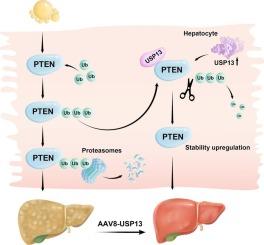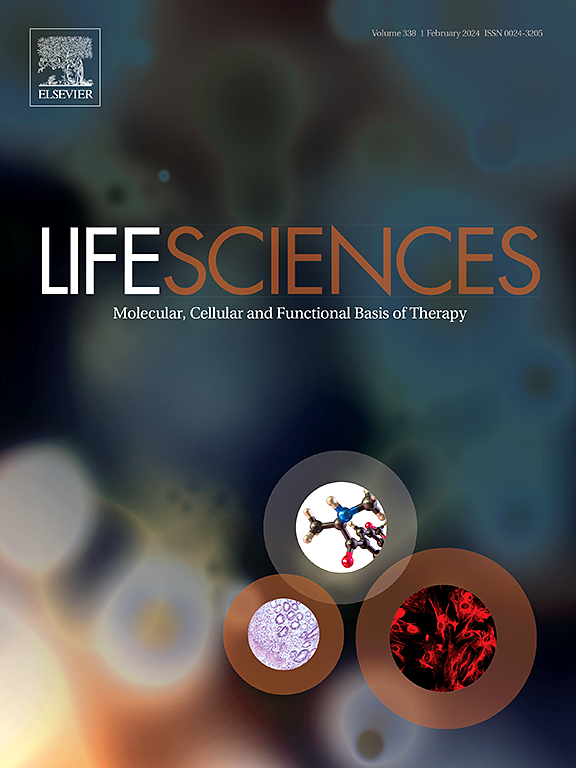USP13 通过靶向 PTEN 改善代谢功能障碍相关性脂肪性肝炎。
IF 5.2
2区 医学
Q1 MEDICINE, RESEARCH & EXPERIMENTAL
引用次数: 0
摘要
目的:泛素特异性蛋白酶13(USP13)在代谢功能障碍相关性脂肪性肝炎(MASH)中的作用仍不清楚。本研究旨在阐明 USP13 在 MASH 进展中的作用:方法:将 THLE-2 细胞置于棕榈酸(PA)中,以产生脂质积累和炎症的体外模型。分别用高脂肪、高果糖和高胆固醇饮食(HFFC)喂养小鼠16周和蛋氨酸/胆碱缺乏饮食(MCD)喂养小鼠4周,建立了两种MASH体内模型。采用Usp13过表达和基因敲除(KO)技术研究其在MASH中的作用:结果:USP13在MASH小鼠肝脏和脂质蓄积与炎症体外模型中的表达明显下调。肝脏过表达 Usp13 能明显缓解肝脏脂肪变性、炎症和纤维化,而敲除 Usp13 则会加重 MASH 表型。从机制上讲,USP13直接与磷酸酶和天丝同源物(PTEN)结合并使其去泛素化,从而提高了PTEN的表达,改善了MASH表型。值得注意的是,在Usp13基因敲除小鼠中过表达Pten可逆转Usp13缺乏导致的MASH恶化:我们的研究结果表明,USP13 通过直接与 PTEN 结合并使其去泛素化来缓解 MASH。USP13-PTEN 轴可能是治疗 MASH 的一个有前景的分子靶点。本文章由计算机程序翻译,如有差异,请以英文原文为准。

USP13 ameliorates metabolic dysfunction-associated steatohepatitis through targeting PTEN
Objective
The role of ubiquitin-specific protease 13 (USP13) in metabolic dysfunction-associated steatohepatitis (MASH) remains unclear. This study aimed to elucidate the role of USP13 in MASH progression.
Methods
THLE-2 cells were subjected to palmitate acid (PA) to generate an in vitro model of lipid accumulation and inflammation. Two in vivo models of MASH were established by feeding mice with a high-fat, high-fructose and high-cholesterol (HFFC) diet for 16 weeks and a methionine/choline-deficient diet (MCD) for 4 weeks, respectively. Usp13 overexpression and knockout (KO) techniques were employed to investigate its role in MASH.
Results
USP13 expression was significantly downregulated in the livers of MASH mice and in the in vitro model of lipid accumulation and inflammation. Hepatic overexpression of Usp13 markedly alleviated liver steatosis, inflammation and fibrosis, while knockout of Usp13 exacerbated the MASH phenotype. Mechanistically, USP13 directly bound to phosphatase and tensin homolog (PTEN) and deubiquitinated it, thereby elevating the PTEN expression and improving the MASH phenotype. Notably, Pten overexpression in Usp13 knockout mice reversed the exacerbation of MASH brought from Usp13 deficiency.
Conclusions
Our findings revealed that USP13 alleviates MASH by directly binding to and deubiquitinating PTEN. The USP13-PTEN axis may represent a promising molecular target for MASH treatment.
求助全文
通过发布文献求助,成功后即可免费获取论文全文。
去求助
来源期刊

Life sciences
医学-药学
CiteScore
12.20
自引率
1.60%
发文量
841
审稿时长
6 months
期刊介绍:
Life Sciences is an international journal publishing articles that emphasize the molecular, cellular, and functional basis of therapy. The journal emphasizes the understanding of mechanism that is relevant to all aspects of human disease and translation to patients. All articles are rigorously reviewed.
The Journal favors publication of full-length papers where modern scientific technologies are used to explain molecular, cellular and physiological mechanisms. Articles that merely report observations are rarely accepted. Recommendations from the Declaration of Helsinki or NIH guidelines for care and use of laboratory animals must be adhered to. Articles should be written at a level accessible to readers who are non-specialists in the topic of the article themselves, but who are interested in the research. The Journal welcomes reviews on topics of wide interest to investigators in the life sciences. We particularly encourage submission of brief, focused reviews containing high-quality artwork and require the use of mechanistic summary diagrams.
 求助内容:
求助内容: 应助结果提醒方式:
应助结果提醒方式:


